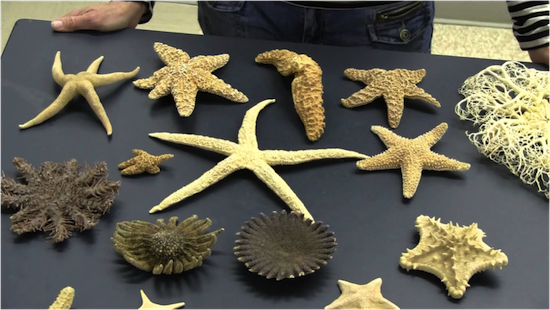
Echinodermata Notes

Echinoderm is the common name given to any member of the Phylum Echinodermata of marine animals. The adults are recognizable by their (usually five-point) radial symmetry, and include such well-known animals as starfish, sea urchins, sand dollars, and sea cucumbers, as well as the sea lilies or "stone lilies". Echinoderms are found at every ocean depth, from the intertidal zone to the abyssal zone. Echinoderms are also the largest phylum that has no freshwater or terrestrial (land-based) representatives.
The echinoderms are important both biologically and geologically and the first definitive members of the phylum appeared near the start of the Cambrian. Biologically, there are few other groupings so abundant in the biotic desert of the deep sea, as well as shallower oceans. The more notably distinct trait, which most echinoderms have, is their remarkable powers of regeneration of tissue, organs, limbs, and of asexual reproduction, and in some cases, complete regeneration from a single limb. Geologically, the value of echinoderms is in their ossified skeletons, which are major contributors to many limestone formations, and can provide valuable clues as to the geological environment.
Echinoderms are globally distributed in almost all depths, latitudes and environments in the ocean. They reach highest diversity in reef environments but are also widespread on shallow shores, around the poles and throughout the deep ocean, where bottom-dwelling and burrowing sea cucumbers are common—sometimes accounting for up to 90% of organisms. While almost all echinoderms are benthic—that is, they live on the sea floor—some sea-lilies can swim, and a few deep-sea sea cucumbers are fully floating. Some crinoids are pseudo-planktonic, attaching themselves to floating logs and debris, although this behaviour was exercised most extensively in the Paleozoic, before competition from such organisms as barnacles restricted the extent of the behaviour. The larvae of echinoderms, especially starfish and sea urchins, are pelagic, and with the aid of ocean currents can be transported for great distances, reinforcing the global distribution of the phylum.